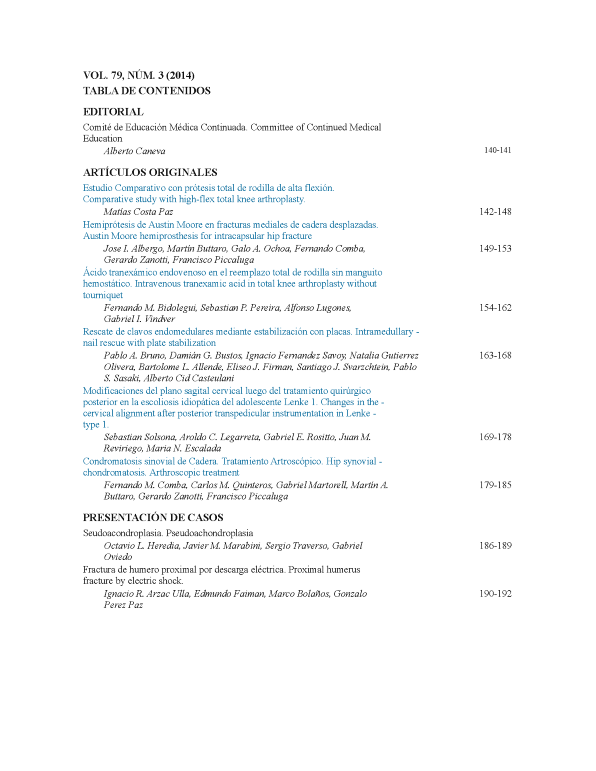Comparative study with high-flex total knee arthroplasty. functional and range of motion results
Main Article Content
Abstract
Downloads
Metrics
Article Details

This work is licensed under a Creative Commons Attribution-NonCommercial-ShareAlike 4.0 International License.
Manuscript acceptance by the Journal implies the simultaneous non-submission to any other journal or publishing house. The RAAOT is under the Licencia Creative Commnos Atribución-NoComercial-Compartir Obras Derivadas Igual 4.0 Internacional (CC-BY-NC.SA 4.0) (http://creativecommons.org/licences/by-nc-sa/4.0/deed.es). Articles can be shared, copied, distributed, modified, altered, transformed into a derivative work, executed and publicly communicated, provided a) the authors and the original publication (Journal, Publisher and URL) are mentioned, b) they are not used for commercial purposes, c) the same terms of the license are maintained.
In the event that the manuscript is approved for its next publication, the authors retain the copyright and will assign to the journal the rights of publication, edition, reproduction, distribution, exhibition and communication at a national and international level in the different databases. data, repositories and portals.
It is hereby stated that the mentioned manuscript has not been published and that it is not being printed in any other national or foreign journal.
The authors hereby accept the necessary modifications, suggested by the reviewers, in order to adapt the manuscript to the style and publication rules of this Journal.
References
Traumatol Arthrosc 2007;15:350-5.
2. Coughlin KM, Incavo SJ, Doohen RR, Gamada K, Banks S, Beynnon BD. Kneeling kinematics after total knee arthroplasty:
anterior-posterior contact position of a standard and a high-flex tibial insert design. J Arthroplasty 2007;22:160-5.
3. Huang HT, Su JY, Wang GJ. The early results of high-flex total knee arthroplasty: a minimum of 2 years of follow-up.
J Arthroplasty 2005;20:674 9.
4. Huddleston JI, Scarborough DM, Goldvasser D, Freiberg A, Malchou H. How often do patients with high-Flex total knee
arthroplasty use high flexion? Clin Orthop Relat Res 2009;467:1898-906.
5. Kim YH, Sohn KS, Kim JS. Range of motion of standard and high-flexion posterior stabilized total knee prostheses: a
prospective, randomized study. J Bone Joint Surg Am 2005;87:1470-5.
6. Kim YH, Choi Y, Oh-Ryong K, Kim JS. Functional outcome and range of motion of high-flexion posterior cruciate-retaining
and high-flexion posterior cruciate substituting total knee prostheses. A prospective, randomized study. J Bone Joint Surg Am
2009;91:753-60.
7. Laskin RS. The effect of a high-flex implant on postoperative flexion after primary total knee arthroplasty. Orthopedics 2007;30
(Suppl):86-8.
8. McCalden RW, MacDonald SJ, Bourne RB, Marr JT. A randomized controlled trial comparing “high-flex” vs “standard”
posterior cruciate substituting polyethylene tibial inserts in total knee arthroplasty. J Arthroplasty 2009;24(Suppl):33-8.
9. Mehin R, Burnett RS, Brasher PMA. Does the new generation of high-flex knee prostheses improve the post-operative range of
movement? A meta-analysis. J Bone Joint Surg Br 2010;92:1429-34.
10. Ng FY, Wong HL, Yau WP, Chiu KY, Tang WM. Comparison of range of motion after standard and high-flexion posterior
stabilised total knee replacement. Int Orthop 2008;32:795-8.
11. Weeden SH, Schmidt R. A randomized, prospective study of primary total knee components designed for increased flexion.
J Arthroplasty 2007;22:349-52.
12. Ritter MA, Harty LD, Davis KE, Meding JB, Berend ME. Predicting range of motion after total knee arthroplasty. J Bone
Joint Surg Am 2003;85:1278-85.
13. Nutton RW, van der Linden ML, Rowe PJ, Gaston P, Wade FA. A prospective randomised double-blind study of functional
outcome and range of flexion following total knee replacement with the NexGen standard and high flexion components. J Bone
Joint Surg Br 2008;90:37-42.
14. Seon JK, Park SJ, Lee KB, Yoon TR, Kozanek M, Song EK. Range of motion in total knee arthroplasty: a prospective
comparison of high-flexion and standard cruciate-retaining designs. J Bone Joint Surg Am 2009;91:672-9.
15. Wohlrab D, Ditl J, Herrschelmann R, Schietsch U, Hein W, Hube R. Does the NexGen LPS flex mobile knee prosthesis
offer advantages compared to the NexGen LPS?: a comparison of clinical and radiological results. Z Orthop Ihre Grenzgeb
2005;143:567-72.

